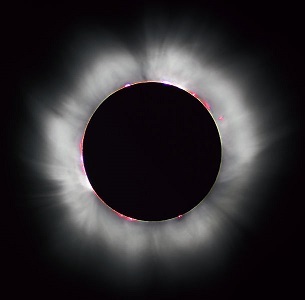Dealing with darkness is something that humans do very poorly, and almost always with a sense of dread or outright fear. At best, we see darkness and light as the Yin-Yang of our existence, both physical and spiritual, and try to strike some kind of balance between dark despair and a lightness of being. But in nature, darkness figures prominently in some very positive ways, such as this total solar eclipse.
Courtesy Luc Viatour
The Dark Constellations
Humans have always marveled in awe at the mystery of the night sky. We have wondered about the many odd things that have been seen there, wandering planets, meteors and comets among them. As you watch the night sky with its glorious carpet of stars, at first earthly thoughts rush about like a clanging background noise. Then you enter an almost wordless state. The astronomer stops hearing an inner voice lecturing to him about the cosmos. The eye picks out patterns and sees that the vista is far from an empty blackness. How strange it is that we have never failed to invent patterns in the stars to honor the heroic figures of our legends. Chinese, Egyptian, Roman and American Indian -- the roll call of celestial artisans spans the millennia.
But in South America, the Incas paid homage to different patterns, patterns that weren't outlined by our familiar pinpoint stars. Instead, they were bounded by the yawning gaps of darkness between the stars. Speckled along the Milky Way, the dark constellations of Yutu the Bird, Hanpatu the Toad and Machacuay the Serpent wind their way through the star clouds. The Celestial Llama Yacana is a dark rift slashed across the Milky Way as it passes overhead across the Inca Empire. It was Yacuna that held back the cosmic floodwaters destined to drown the Sun for eternity. In this blot of emptiness, the Incas found their darkest thoughts realized, and their reasons for daily human sacrifice to keep the sun shining. Ironically, it is in these dark constellations that new generations of stars are born out of dense, collapsing dust clouds. How curious to think that one civilization's gloomy and terrifying view hides within it another civilization's stellar rebirths and the promise of future light!
Dark Moon Rising
You have all heard about blue moons, right? The second full moon of a calendar month is often called the blue moon. On July 31, 2015, we will have the next blue moon, the first since Aug. 31, 2012. Then we get to wait for the Year of the Twin Blue Moons, 2018, with blue moons on Jan. 31 and March 31. Newspapers like to report blue moons because who doesn't like the dazzling illumination of the full moon and its clock-like comings and goings every lunar month? We even name each of the full moons in a normal year, the most common being the harvest moon, which occurs nearest the autumnal equinox. The next time a full moon occurs within a day or two of the equinox will be on Sept. 23, 2015.
But in some circles the new moon is of greater interest than its iridescent twin. Sometimes called Lilith or Ischtar, by some accounts her dark nature makes her a perfect mate for Satan. The second new moon of a calendar month is called the black moon or the spinner moon. This year we have two black moons. The first occurred on Jan. 30, 2014, and the next one will happen in a few weeks, on March 30, 2014. You will have to wait until Sept. 30, 2016, for the next black moon. What you plan to do about this happenstance is up to you, but good luck trying to spot this moon against the glare of the sun, but remember that it is only during new moon that one sees the dazzling coronal of light surrounding the sun at total eclipse!
Dark Matters
Yes, of course the night sky is dark, but to an astronomer there is something even more troubling about it. We have spent centuries classifying and studying the light-giving stars and galaxies that speckle the universe, but now we know there is far more to the universe than those brilliant points in the sky that are so easy to study with telescopes and satellites. Spread throughout the universe, and occasionally clumped into amorphous clouds, there seems to be some ineffable ingredient we call dark matter. There is six times more of this stuff than all the matter in all the stars and galaxies we can see. In some sense astronomers have been hoodwinked into thinking the ingredients to the universe we can see are the ones that control its destiny. In fact, they are only the tracers of a vaster ingredient that seems utterly hidden from telescopic view. Imagine watching distant hikers carrying flashlights up the side of a mountain at night. They take a torturous path that follows the underlying rock, much as visible stars and galaxies follow the gravitational pull of the invisible dark matter.
We are pretty certain that it is not even matter as we know it. There is no ingredient in our standard model of matter and forces that looks anything like dark matter. Instead we have to delve into theories beyond what physicists call the standard model to find candidates. So far, some of the simplest possibilities for candidate dark matter particles have already been slayed by the fabulous Large Hadron Collider at CERN. This doesn't leave us with much to go on in figuring out what the universe really contains. Stay tuned!
So paradoxically, as we consider the easy-to-see light in the world, it is the hidden things lurking in the darkness that control much of the destiny of the universe, offers the rebirth of stars and solar systems from its substance, and allows us to see our Sun's ineffable halo!
